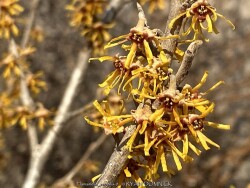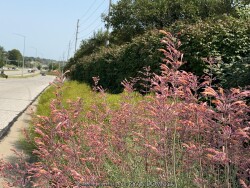

Sunset Agastache (Agastache rupestris) is a cold hardy, native hybrid perennial that blooms from mid to late summer and sporadically into the fall. This variety features a profusion of orange and pinkish flowers that attract hummingbirds and bumblebees. Both the flowers and foliage have a strong minty licorice scent when touched, and aromatic foliage helps to deter both deer and rabbits. Having desert heritage, it resents poor drainage and winter moisture. To counteract that in Kansas, plant in full sun on berm with poor sandy or rocky soil with no irrigation.
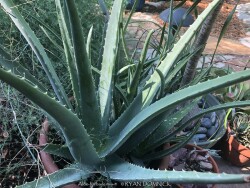

Giant Aloe is typically grown in warmer zones. Considered a tropical or succulent in Kansas and used as summer patio plants with white flowers and bright green foliage. Be prepared to give away offsets to all your friends! Water sparingly and place in mostly shade followed by full sun after acclimated. Giant Aloe can tolerate frost but protect from temperatures below 25 degrees F and move into a cold garage or basement over the winter with minimal watering. Do not allow the pot with rootball to freeze solid or go below 25 degrees for more than a few hours. It is important to avoid the combination of wet and cold. As a winter house plant, it will look presentable all winter long with just no waterings. As a permanent house plant, provide bright light and allow the soil to dry between waterings for many years of carefree enjoyment. Plants grown permanently indoors may begin to elongate stretching for light producing weak new growth. It can be hard to reproduce the intense UV sunlight they need so moving outside for the summer is best.Generally if moving outside for the summer, allow 3-4 weeks of part shade or morning sun before placing in full sun. Giant aloe is one of the slowest plants to re-acclimate to bright sunlight so this might take a month or so of protecting from full sun. Potted plants are very low maintenance. Division and re-potting will need to eventually occur as plants will get top heavy and offsets will fall out. I have never seen any insect problems on this plant. Survives each year a a long lasting annual in out display garden until about 18-20 degrees...usually into December before it looks damaged and unsightly.
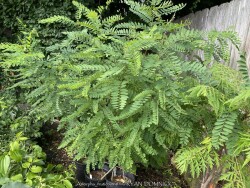

False Indigo Shrub (Amorpha fruticosa) is a 6-10 ft., loose, airy shrub which often forms dense thickets. The blooming season is relatively short but the pinnately compound leaves offers lasting interest and a "Wow" factor. The foliage is pinnately compound, fine-textured, and turns gold in the fall lasting for a week or two. Older plantings may be rejuvenated as they do develop a leggy character with the majority of their foliage on the upper third of the plant. This is a species of flowering plant in the legume family Fabaceae so it is able to make its own nitrogen. False Indigo Shrub tolerates many types of soil including wet sandy soils. Other names include desert false indigo, false indigo-bush, and bastard indigobush. It is native to North America and has potential to be invasive in parts of the country but not so much in Kansas.


***Description for this plant available with future update!*** >>>>> Plant Delights Nursery says "This little-known but easy-to-grow voodoo lily is native to the Yunnan Province of China. The stalks are either solid green or green with grey spots and are each topped with a glossy green leaf. Amorphophallus albus is a fast offsetting species that forms a nice 2' wide patch (in 5 years) in the woodland garden. In spring, just as the leaf emerges, a 1' tall flower stalk appears alongside it with a 6-8" tall flower perched on top. Each flower resembles a large ivory shell showcasing a white, cigar-like appendage...green at the tip and white at the base." >>>>>>>>>> Voodoo (Amorphophallus konjac) lily is a perennial tuber generally grown as a curiosity for its interesting foliage. The single leaf consists of a stalk (petiole) with mottled pinkish-gray and olive green coloration. The single intricate leaf has horizontal sections giving it a tropical umbrella-like effect. Larger tubers (about the size of a grapefruit or larger) may produce a single "flower" in spring before the foliage appears. The "flower" is actually a large shiny purple to maroon ruffled spathe. When in bloom it produces an odor like a dead animal for 1 day. This is intended to attract the carrion flies that are its natural pollinators. It is possible to overwinter these in the ground in Kansas by placing a 6-12" mound of mulch over deeply planted tubers. New growth will usually be delayed until June but quickly regains full height and will get bigger each year; buried tubers are hardy to zone 6a. They can also be grown as a flowering summer patio plant. If growing as a potted plant and trying to overwinter, allowing the foliage to frost is ok, it will not kill the root system. However, do not allow the pot with rootball to freeze solid or go below 20 degrees for more than a few hours; move into a cold garage or basement over the winter with no watering. Cut back and allow to go dormant and place entire pot back out in April or May with a time-release fertilizer. Plants can get huge and exotic looking as a potted patio plant. Grown in Japan and Korea as an edible corm.
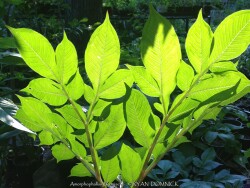

Voodoo (Amorphophallus konjac) lily is a perennial tuber generally grown as a curiosity for its interesting foliage. The single leaf consists of a stalk (petiole) with mottled pinkish-gray and olive green coloration. The single intricate leaf has horizontal sections giving it a tropical umbrella-like effect. Larger tubers (about the size of a grapefruit or larger) may produce a single "flower" in spring before the foliage appears. The "flower" is actually a large shiny purple to maroon ruffled spathe. When in bloom it produces an odor like a dead animal for 1 day. This is intended to attract the carrion flies that are its natural pollinators. It is possible to overwinter these in the ground in Kansas by placing a 6-12" mound of mulch over deeply planted tubers. New growth will usually be delayed until June but quickly regains full height and will get bigger each year; buried tubers are hardy to zone 6a. They can also be grown as a flowering summer patio plant. If growing as a potted plant and trying to overwinter, allowing the foliage to frost is ok, it will not kill the root system. However, do not allow the pot with rootball to freeze solid or go below 20 degrees for more than a few hours; move into a cold garage or basement over the winter with no watering. Cut back and allow to go dormant and place entire pot back out in April or May with a time-release fertilizer. Plants can get huge and exotic looking as a potted patio plant. Grown in Japan and Korea as an edible corm.
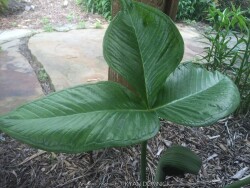

Japanese Cobra Lily (Arisaema ringens) is planted for its bright green foliage and bazaar "Cobra" hood-like flowers. Native to rich Japanese forests in humusy, medium to wet, well-drained soil in part shade to full shade, it needs a good location in the garden and will be a focal point. If foliage depreciates from drought, the plants may be cut to the ground with some regrowth and flowering possible in the fall. Combine with shade garden plants that will fill the space in summer such as hostas. Although this aroid offsetts, it is rare and uncommonly available for sale.
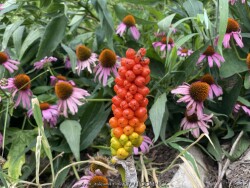

Italian Painted Arum (Arum italicum 'Pictum') is native to the Mediterranean region. It has a reversed or off-schedule life cycle; growing when other plants have already shed their leaves to take advantage of sunlight and lack of competition. It is often planted for its unusual evergreen leaf pattern and color resembling a bright green house plant growing outside in winter. Foliage goes dormant by June but is followed by naked stalks emerging from the ground with reddish orange berries. Foliage re-appears in fall and lasts well into winter untouched. If low temperatures hit 0 degrees F, foliage finally dies back to the ground and re-emerges in early spring to repeat the life cycle. If low temperatures hit -15 degrees F, it may kill an un-mulched plant; protect any zone 5/6 perennial with a 2-3" thick layer of mulch. Grow in average to rich well drained garden soil in full sun or full shade with everything in between. Moderate dry shade does not seem to be a problem because arum goes dormant anyways in the heat of summer. This holds true for planting in sunny locations to. Combine with shade garden plants that will fill the space in summer such as hostas or solomon seal. Also great when combined with late-emerging spring perennials (like plumbago, hardy hibiscus, and orange butterfly weed) because it fills that early spring space starting to grow extremely early with freeze-resistant foliage. Then later in the summer when Arum goes dormant, these plants hide the dying foliage and void left in the garden; what a great way for two species to share the same garden space! It has potential to be invasive in parts of the country such as the Pacific Northeast USA but not in Kansas. It is very stable but does not self-seed or spread in Lawrence, KS gardens; bulb offsets develop but only thicken the existing clump over time. Considered to be a great permatanet multi-season perennial for your garden.
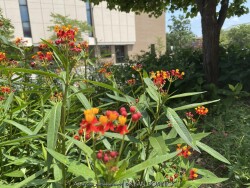

***Description for this plant available with future update!***
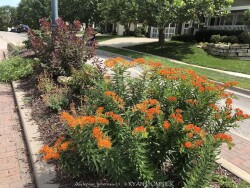

Orange Butterfly Milkweed (Asclepias tuberosa) is a native wildflower with bright orange flowers occurring mostly in dry open habitats and is very common in the prairies and grasslands of the Midwest and Great Plains. Common in Kansas, this beautiful native wildflower is also found from Maine to South Dakota to the desert southwest to Florida. In ideal locations established Butterfly Weeds are very showy with multiple flowering stems spreading across the two foot high plant. Mature plants also have a deep tap root that extends down a foot or more allowing them superb drought tolerance. This rugged species thrives in sunny locations, in dry sandy soil or well-drained loam. More permanent locations include limestone bluffs, rocky prairies, and Great Plains. This wildflower also colonizes readily with wind blown fluffy seeds and will grow under the mower blades sometimes completing their flowering before yearly mowing along state highways. Foliage is often green, upright and attractive. Flowering is long lasting usually 4-6 weeks with interesting seed pods developing later. These eventually open and seeds float away. Reseeding is rare in the garden as mulch will generally eliminate that possibility. In the landscape, Orange Butterfly Weed can be used in any dry soil situation including berms, hot south or west side of the house, or any other full sun area. These will grow in poor rocky, sandy or clayish soils and even rich organic soils as a beautiful flowering annual. With our average 40 inches of rain per year in eastern Kansas, extra irrigation is not recommended. When used as an annual with irrigation and rich garden soil, you can expect the amazing growth and summer flowering followed by a probable root rot in the winter. Orange Butterfly Weed can be planted in parking lot medians and other hell strips as a very durable groundcover. Orange Butterfly Weed can also thrive in an above-ground perennial planter (with appropriate potting soil) year-round surviving the winter coldness in Eastern Kansas (zone 6a/5b). In any situation, combine with any other flower colors except orange. There is quite a lot of diversity within the species so plants from different locales will have different foliage and flower shades adapted to the site. Flower color can range from almost red to pure yellow and everything in between.
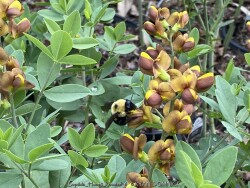

The False Indigo species (Baptisia) features beautiful compact bluish green leaves arranged in groups of three. Like many members in the legume family, they are nitrogen fixing plants which means they produce their own nitrogen in the soil through a symbiotic relationship with bacteria. The flowers bloom above the foliage normally in April and May. Common baptisia flower colors include white, purple, lavender, yellow, and pink as well as uncommon colors ranging from deep purple to maroon and even coppery orange. Considered a great North American native three season plant, the foliage always emerges very attractive followed by flowers that do not need deadheading. Foliage generally lasts pretty nice through hot summers and into fall turning black with first freeze. Seed pods also turn charcoal black when ripe and have considerable ornamental interest and useful in dried flower arrangements. At some point in the fall, it can be cut down early for a clean look or left for winter interest. Baptisia generally do well in droughty clay soils in full to part sun. There is only one pest that may create problems called the Genista Broom Moth. It may occur in Kansas when weather conditions are consistently dry and over 95 degrees F. It is treatable if you act fast but if not, it only destroys the foliage late in the season and does not kill the plant. Baptisia has several enormous spreading taproots which store water and energy and can make transplanting difficult. Plantings look good as specimen or in small groups; and it's ok even preferable if they grow together and touch other plants. That helps eliminate available sunlight and discourages weeds. It is hard to picture a native plant garden or any perennial garden without Baptisia. Considered a once "it's there, it's always there" long lived plant. Baptisia 'Honey Roasted' features long 10" spikes of dark mahogany flowers have bright yellow keels, producing a wonderful bicolor effect. The bushy habit is jam-packed with flowers when it is in bloom early in the growing season. Flowers lighten to yellow as the flowers mature. This extremely long-lived perennial could be used instead of a shrub in landscape settings, with minimal care required to thrive year after year.
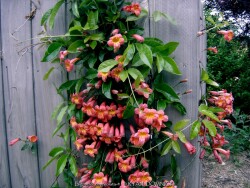

Crossvine (Bignonia capreolata) is a highly ornamented evergreen vine native to the southeast west to Oklahoma and Texas. Fantastic blooms completely cover the plant and occur on old wood in the late spring for about 3-5 weeks then sporadically during the summer. Flowers are trumpet-shaped, orange and red with yellow throats. Although in the same family as trumpet vine (campus radicans), crossvine is not invasive. Plant crossvine on fences or pergolas where you want good coverage but not anything sprawling too far away from the structure needing pruning. Considered to be one of the lowest maintenance of all vines. Crossvine prefer for part to full sun on in medium to rich soils and are able to tolerate drought and brief flooding once established. There are no serious pests or diseases to worry about. Crossvine has thrived in our Lawrence Kansas zone 6a display garden for over 15 years enduring a few occasions of -10° or colder winters. Winter foliage turns purple and remains evergreen till about -10. We have seen -18° without any dieback on the vine other than the loss of foliage that year. This great vine has it all, beautiful flowers, evergreen foliage, and constrained growth habit!
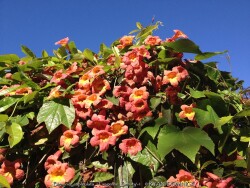

Crossvine (Bignonia capreolata) is a highly ornamented evergreen vine native to the southeast west to Oklahoma and Texas. Fantastic blooms completely cover the plant and occur on old wood in the late spring for about 3-5 weeks then sporadically during the summer. Flowers are trumpet-shaped, orange and red with yellow throats. Although in the same family as trumpet vine (campus radicans), crossvine is not invasive. Plant crossvine on fences or pergolas where you want good coverage but not anything sprawling too far away from the structure needing pruning. Considered to be one of the lowest maintenance of all vines. Crossvine prefer for part to full sun on in medium to rich soils and are able to tolerate drought and brief flooding once established. There are no serious pests or diseases to worry about. Crossvine has thrived in our Lawrence Kansas zone 6a display garden for over 15 years enduring a few occasions of -10° or colder winters. Winter foliage turns purple and remains evergreen till about -10. We have seen -18° without any dieback on the vine other than the loss of foliage that year. This great vine has it all, beautiful flowers, evergreen foliage, and constrained growth habit! Bignonia capreolata 'Tangerine Beauty' is noted for its tangerine flowers and slightly improved cold hardiness.
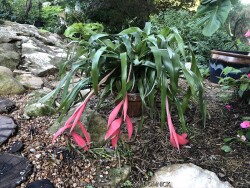

Billbergia Bromeliad / Friendship Plant (Tropical), is also known as Billbergia nutans


Brugmansia is a genus of seven species of flowering plants in the nightshade family Solanaceae from South America. It is typically grown in warmer zones as a shrub or tree but is extinct from the wild (only known in cultivation). Along with other tropicals and succulents in Kansas, Angel Trumpet Flower is usually grown as summer patio plant with amazing foot-long hanging flowers and sweet aroma. Water regularly and place in full sun or part shade. Protect from temperatures below 32 degrees F and move into a cold garage or basement over the winter with minimal watering. Do not allow the pot with rootball to freeze solid or go below 28 degrees for more than a few hours. Allow to go dormant as needed with little care, just cut off dead foliage/twigs and place back out in April or May with a time-release fertilizer. You may also propagate this plant easily by cutting off dormant twigs/branches and stuffing them into the ground. Notice that I didn't say rooting hormone or even being careful was necessary! Landscapers also plant these as an annual in the ground for an enormous tropical effect with fragrant flowers and growth reaching 5-8' in one season from a 1gal container! It is possible to overwinter Brugmansia in the ground in Kansas as a woody perennial. In our trial gardens in Lawrence, KS (zone 6a), a one year established specimen planted in our annual bed was mulched 12-18" thick with leaf mulch survived -10 degrees F. The dieback was deep into the ground but somehow came back from a piece of deep root. The leaf mulch was also well rotted and formed somewhat of an ice barrier insulating effect. Brugmansia species are amongst the most toxic of ornamental plants so do not eat and part of this plant! Brugmansia 'Charles Grimaldi' features orange flowers.
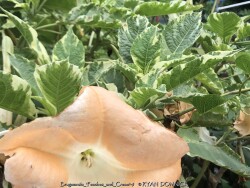

Brugmansia is a genus of seven species of flowering plants in the nightshade family Solanaceae from South America. It is typically grown in warmer zones as a shrub or tree but is extinct from the wild (only known in cultivation). Along with other tropicals and succulents in Kansas, Angel Trumpet Flower is usually grown as summer patio plant with amazing foot-long hanging flowers and sweet aroma. Water regularly and place in full sun or part shade. Protect from temperatures below 32 degrees F and move into a cold garage or basement over the winter with minimal watering. Do not allow the pot with rootball to freeze solid or go below 28 degrees for more than a few hours. Allow to go dormant as needed with little care, just cut off dead foliage/twigs and place back out in April or May with a time-release fertilizer. You may also propagate this plant easily by cutting off dormant twigs/branches and stuffing them into the ground. Notice that I didn't say rooting hormone or even being careful was necessary! Landscapers also plant these as an annual in the ground for an enormous tropical effect with fragrant flowers and growth reaching 5-8' in one season from a 1gal container! It is possible to overwinter Brugmansia in the ground in Kansas as a woody perennial. In our trial gardens in Lawrence, KS (zone 6a), a one year established specimen planted in our annual bed was mulched 12-18" thick with leaf mulch survived -10 degrees F. The dieback was deep into the ground but somehow came back from a piece of deep root. The leaf mulch was also well rotted and formed somewhat of an ice barrier insulating effect. Brugmansia species are amongst the most toxic of ornamental plants so do not eat and part of this plant! Brugmansia 'Peaches and Cream' features white and green variegated foliage and light orange flowers.
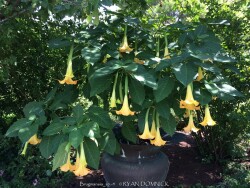

Brugmansia is a genus of seven species of flowering plants in the nightshade family Solanaceae from South America. It is typically grown in warmer zones as a shrub or tree but is extinct from the wild (only known in cultivation). Along with other tropicals and succulents in Kansas, Angel Trumpet Flower is usually grown as summer patio plant with amazing foot-long hanging flowers and sweet aroma. Water regularly and place in full sun or part shade. Protect from temperatures below 32 degrees F and move into a cold garage or basement over the winter with minimal watering. Do not allow the pot with rootball to freeze solid or go below 28 degrees for more than a few hours. Allow to go dormant as needed with little care, just cut off dead foliage/twigs and place back out in April or May with a time-release fertilizer. You may also propagate this plant easily by cutting off dormant twigs/branches and stuffing them into the ground. Notice that I didn't say rooting hormone or even being careful was necessary! Landscapers also plant these as an annual in the ground for an enormous tropical effect with fragrant flowers and growth reaching 5-8' in one season from a 1gal container! It is possible to overwinter Brugmansia in the ground in Kansas as a woody perennial. In our trial gardens in Lawrence, KS (zone 6a), a one year established specimen planted in our annual bed was mulched 12-18" thick with leaf mulch survived -10 degrees F. The dieback was deep into the ground but somehow came back from a piece of deep root. The leaf mulch was also well rotted and formed somewhat of an ice barrier insulating effect. Brugmansia species are amongst the most toxic of ornamental plants so do not eat and part of this plant! Flowers come in Orange, Red, Pink, and White.


Brugmansia is a genus of seven species of flowering plants in the nightshade family Solanaceae from South America. It is typically grown in warmer zones as a shrub or tree but is extinct from the wild (only known in cultivation). Along with other tropicals and succulents in Kansas, Angel Trumpet Flower is usually grown as summer patio plant with amazing foot-long hanging flowers and sweet aroma. Water regularly and place in full sun or part shade. Protect from temperatures below 32 degrees F and move into a cold garage or basement over the winter with minimal watering. Do not allow the pot with rootball to freeze solid or go below 28 degrees for more than a few hours. Allow to go dormant as needed with little care, just cut off dead foliage/twigs and place back out in April or May with a time-release fertilizer. You may also propagate this plant easily by cutting off dormant twigs/branches and stuffing them into the ground. Notice that I didn't say rooting hormone or even being careful was necessary! Landscapers also plant these as an annual in the ground for an enormous tropical effect with fragrant flowers and growth reaching 5-8' in one season from a 1gal container! It is possible to overwinter Brugmansia in the ground in Kansas as a woody perennial. In our trial gardens in Lawrence, KS (zone 6a), a one year established specimen planted in our annual bed was mulched 12-18" thick with leaf mulch survived -10 degrees F. The dieback was deep into the ground but somehow came back from a piece of deep root. The leaf mulch was also well rotted and formed somewhat of an ice barrier insulating effect. Brugmansia species are amongst the most toxic of ornamental plants so do not eat and part of this plant! Flowers come in Orange, Red, Pink, and White.
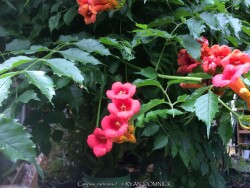

Trumpet vine (Campsis radicans) features shiny dark green foliage, orange-red trumpet-shaped summer flowers, green bean-like seed pods, and gold fall color. Flowers are very attractive to hummingbirds. Trumpet vine is native to the eastern United States including Kansas. Easily grown in a wide variety of soils including heady clay. It is usually grown on pergolas, trellises, and chain-link fences. Beware that this is an extremely vigorous plant that crowds out most weeds and is itself weed-like, with a very spreading growth habit. Best planted and allowed to grow in isolated areas or in horrible soils where no other plant will grow; mowing around it generally stops the yearly spread. Three beautifum mature plants in our display garden grow up posts on the North side of our covered awning behind our shop. They have been thriving for 15 plus years, growing in extremely compacted ab-3 gravel smashed into clay "soil" that is driven on by trucks and constantly walked on. A pick-axe will bounce off with each powerful swing! Now that is a tough "Once it's there, it's there forever" plant!
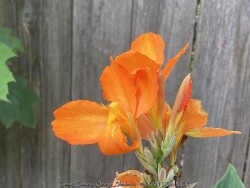

Cannas are typically grown for their continuous summer flowers and vertical wide-leaf foliage. The plants are large tropical and subtropical herbaceous perennials with a rhizomatous rootstock native to areas with a summer monsoon and dry winter. They can be grown as flowering summer patio plants. If growing as a potted plant and trying to overwinter, allowing the foliage to frost is ok, it will not kill the root system. However, do not allow the pot with rootball to freeze solid or go below 20 degrees for more than a few hours; move into a cold garage or basement over the winter with no watering. Cut back and allow to go dormant and place entire pot back out in April or May with a time-release fertilizer. Another more labor intensive way to overwinter cannas is to remove them from the dirt, dust with fungicide, place in box with sawdust, and keep in the refrigerator. We consider this method old-fashioned and too much work but ok if you only want to save a few pieces. If digging from the ground, just save a chunk with the dirt intact and place into a large pot in the garage. During the growing season, fertilize, water regularly, and place in full sun. You may also plant these in the ground for an enormous tropical effect! It is possible to overwinter these in the ground in Kansas by mulching 4-8" thick over deeply planted rhizomes. New growth will usually be slightly delayed but quick to regain full height. In our trial gardens in Lawrence, KS (zone 6a), the following varieties survived after being mulched 6-12" with leaf mulch to -17 degrees F. (Canna 'Daddy's Buckaroo',Canna 'Omega',Canna indica 'Red Stripe',Canna indica 'Ellen's Super Orange', Canna indica 'Wyoming') During the arctic blast of February, 2021, lows down to -17 degrees F on Feb 16th, 2021 were recorded. The longevity of this cold blast was also impressive: 10 days on a row with highs of 10-15 degrees F or lower, 8 nights of lows in the single digits and negatives, and 36 straight hours of 0 degrees F and mostly lower. Canna 'Cannova Orange Shades' is a dwarf variety with green leaves and bright orange flowers.
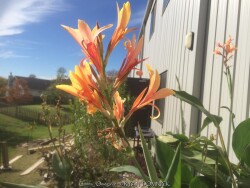

Cannas are typically grown for their continuous summer flowers and vertical wide-leaf foliage. The plants are large tropical and subtropical herbaceous perennials with a rhizomatous rootstock native to areas with a summer monsoon and dry winter. They can be grown as flowering summer patio plants. If growing as a potted plant and trying to overwinter, allowing the foliage to frost is ok, it will not kill the root system. However, do not allow the pot with rootball to freeze solid or go below 20 degrees for more than a few hours; move into a cold garage or basement over the winter with no watering. Cut back and allow to go dormant and place entire pot back out in April or May with a time-release fertilizer. Another more labor intensive way to overwinter cannas is to remove them from the dirt, dust with fungicide, place in box with sawdust, and keep in the refrigerator. We consider this method old-fashioned and too much work but ok if you only want to save a few pieces. If digging from the ground, just save a chunk with the dirt intact and place into a large pot in the garage. During the growing season, fertilize, water regularly, and place in full sun. You may also plant these in the ground for an enormous tropical effect! It is possible to overwinter these in the ground in Kansas by mulching 4-8" thick over deeply planted rhizomes. New growth will usually be slightly delayed but quick to regain full height. In our trial gardens in Lawrence, KS (zone 6a), the following varieties survived after being mulched 6-12" with leaf mulch to -17 degrees F. (Canna 'Daddy's Buckaroo',Canna 'Omega',Canna indica 'Red Stripe',Canna indica 'Ellen's Super Orange', Canna indica 'Wyoming') During the arctic blast of February, 2021, lows down to -17 degrees F on Feb 16th, 2021 were recorded. The longevity of this cold blast was also impressive: 10 days on a row with highs of 10-15 degrees F or lower, 8 nights of lows in the single digits and negatives, and 36 straight hours of 0 degrees F and mostly lower. Canna 'Omega' is a tall variety with blue-green leaves and orange flowers. This variety is the most cold hardy of the cannas due to its vigorous deep growing rhizomes. The rate of spread is faster so provide a larger space for this plant. This canna can also grow in standing water as a potted plant in water gardens or rain gardens.
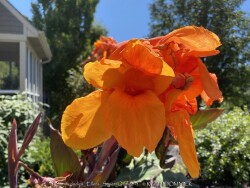

Cannas are typically grown for their continuous summer flowers and vertical wide-leaf foliage. The plants are large tropical and subtropical herbaceous perennials with a rhizomatous rootstock native to areas with a summer monsoon and dry winter. They can be grown as flowering summer patio plants. If growing as a potted plant and trying to overwinter, allowing the foliage to frost is ok, it will not kill the root system. However, do not allow the pot with rootball to freeze solid or go below 20 degrees for more than a few hours; move into a cold garage or basement over the winter with no watering. Cut back and allow to go dormant and place entire pot back out in April or May with a time-release fertilizer. Another more labor intensive way to overwinter cannas is to remove them from the dirt, dust with fungicide, place in box with sawdust, and keep in the refrigerator. We consider this method old-fashioned and too much work but ok if you only want to save a few pieces. If digging from the ground, just save a chunk with the dirt intact and place into a large pot in the garage. During the growing season, fertilize, water regularly, and place in full sun. You may also plant these in the ground for an enormous tropical effect! It is possible to overwinter these in the ground in Kansas by mulching 4-8" thick over deeply planted rhizomes. New growth will usually be slightly delayed but quick to regain full height. In our trial gardens in Lawrence, KS (zone 6a), the following varieties survived after being mulched 6-12" with leaf mulch to -17 degrees F. (Canna 'Daddy's Buckaroo',Canna 'Omega',Canna indica 'Red Stripe',Canna indica 'Ellen's Super Orange', Canna indica 'Wyoming') During the arctic blast of February, 2021, lows down to -17 degrees F on Feb 16th, 2021 were recorded. The longevity of this cold blast was also impressive: 10 days on a row with highs of 10-15 degrees F or lower, 8 nights of lows in the single digits and negatives, and 36 straight hours of 0 degrees F and mostly lower. Canna indica 'Ellen's Super Orange' is a tall variety with reddish-green leaves and bright orange flowers. This variety is among the most cold hardy of the cannas due to its vigorous deep growing rhizomes. Our original plant came from a residential garden in Lawrence, KS.
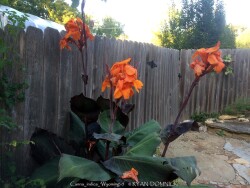

Cannas are typically grown for their continuous summer flowers and vertical wide-leaf foliage. The plants are large tropical and subtropical herbaceous perennials with a rhizomatous rootstock native to areas with a summer monsoon and dry winter. They can be grown as flowering summer patio plants. If growing as a potted plant and trying to overwinter, allowing the foliage to frost is ok, it will not kill the root system. However, do not allow the pot with rootball to freeze solid or go below 20 degrees for more than a few hours; move into a cold garage or basement over the winter with no watering. Cut back and allow to go dormant and place entire pot back out in April or May with a time-release fertilizer. Another more labor intensive way to overwinter cannas is to remove them from the dirt, dust with fungicide, place in box with sawdust, and keep in the refrigerator. We consider this method old-fashioned and too much work but ok if you only want to save a few pieces. If digging from the ground, just save a chunk with the dirt intact and place into a large pot in the garage. During the growing season, fertilize, water regularly, and place in full sun. You may also plant these in the ground for an enormous tropical effect! It is possible to overwinter these in the ground in Kansas by mulching 4-8" thick over deeply planted rhizomes. New growth will usually be slightly delayed but quick to regain full height. In our trial gardens in Lawrence, KS (zone 6a), the following varieties survived after being mulched 6-12" with leaf mulch to -17 degrees F. (Canna 'Daddy's Buckaroo',Canna 'Omega',Canna indica 'Red Stripe',Canna indica 'Ellen's Super Orange', Canna indica 'Wyoming') During the arctic blast of February, 2021, lows down to -17 degrees F on Feb 16th, 2021 were recorded. The longevity of this cold blast was also impressive: 10 days on a row with highs of 10-15 degrees F or lower, 8 nights of lows in the single digits and negatives, and 36 straight hours of 0 degrees F and mostly lower. Canna indica 'Wyoming' is a medium variety with reddish-green leaves and bright orange flowers.
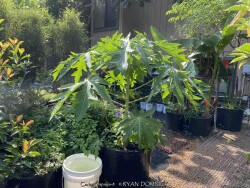

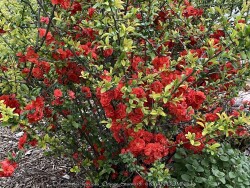

Double Take® Orange Quince (Chaenomeles 'Double Take Orange') features huge flowers on a thornless plant. It's so beautiful you may overlook its survivalist skills! Heat and drought tolerant, this plant will delight you each spring with candy colored blooms. Double Take Orange puts on a spectacular spring display of large double flowers with intense orange color - you'll do a double take! More than just pretty flowers, the Double Take Quinces are easy to care for, having neither thorns or fruit. Once established, they are extremely drought tolerant. Developed by Dr. Tom Ranney and his team at the Mountain Crops Research & Extension Center in beautiful North Carolina, Orange Storm and the other Double Take Quinces are sure to brighten spring gardens across the United States. Uses Notes: Excellent for hedging, mass planting and cut flower gardens. A spectacular early season specimen for the mixed border. Maintenance Notes: Prune to shape after flowering. Apply a controlled release fertilizer in spring. Formerly known as Double Take 'Orange Storm' quince. In Eastern Kansas, this cultivar performs WELL with just about everything nature has to challenge it! Heat and drought are tolerated reasonably well but with some foliage decline by late summer and no fall color. This is made up for by the extremely reliable blooming season that fills up the month of April when many other plants are not in full swing yet. Cold tolerance or flower bud loss is no problem in our zone 6. No serious disease or pest problems. All Proven Winners® plants are legally propagated, healthy and vigorous, true to name, and tagged with color pictures and growing information.


Double Take® Pink Quince (Chaenomeles 'Double Take Pink') features huge flowers on a thornless plant! You'll do a double take when you see this quince that looks like a camellia. Double Take Pink puts on a spectacular early season display of pink blooms. The large, double flowers are excellent in cut flower arrangements. Bright spring flowers are only the beginning of the Double Take quince's appeal: they're also thornless, and do not produce fruit. Extremely drought tolerant once established, these early spring charmers are excellent landscape plants and real survivalists in tough climates. Developed by Dr. Tom Ranney and his team at the Mountain Horticultural Crops Research & Extension Center in beautiful North Carolina, they are sure to brighten spring landscapes across the United States.Uses Notes: Intense early spring color is excellent for mixed borders and cutting gardens. Also good for hedging and mass plantings. Maintenance Notes: Trim to shape after flowering. Apply a controlled release fertilizer in spring. Formerly sold as Double Take 'Pink Storm' quince. In Eastern Kansas, this cultivar performs WELL with just about everything nature has to challenge it! Heat and drought are tolerated reasonably well but with some foliage decline by late summer and no fall color. This is made up for by the extremely reliable blooming season that fills up the month of April when many other plants are not in full swing yet. Cold tolerance or flower bud loss is no problem in our zone 6. No serious disease or pest problems. All Proven Winners® plants are legally propagated, healthy and vigorous, true to name, and tagged with color pictures and growing information.
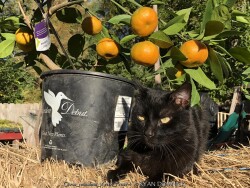

Arctic Frost Hardy Satsuma (Citrus reticulata 'Arctic Frost') is typically grown in warmer zones as far North as Dallas (Zone 8a). Along with other tropicals and succulents in Kansas, Arctic Frost is usually grown as summer patio plant and then moved inside for the winter. Move to bright area in a cold garage, basement, or window over the winter with monthly watering. During the growing season, water regularly and place in full sun. If grown in a larger 20 gallon pot or so, it may flower and fruit when 4-5 feet tall after a few years. Before hard freezes come in the fall, move inside to protect from temperatures below 25 degrees F if you want fruit. Flower buds form in the winter on citrus trees. If you want evergreen foliage, protect with anything lower than 15 degrees F. It will tolerate down to 10 degrees F with complete defoliation and around 0 degrees F with complete wood kill down to the base of the trunk. Because it is grown on its own root system, it will come back true from winter kill down to the ground. A plant in our Lawrence, KS cold frame survived 0 degrees F for a few days and grew 3-4' back the following year. Don't expect flowers and fruit in these conditions though.
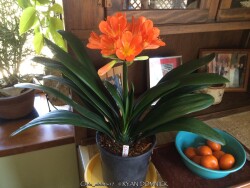

Clivia (Clivia miniata) has attractive dark green, wide, glossy, curved foliage along with long lasting bright orange flowers followed by red fruits. Also sometimes called Bush lily or Kaffir lily, it is native to seasonal semi-dry woodland habitats in South Africa. It is best used as a houseplant or full-shade summer patio plant in Kansas. Place in full shade in areas where occasional extra watering can happen including that which comes from rainfall. Repotting may or may not be needed depending on how large you want the plant to grow; plants can continue to grow thicker and tolerate extremely root-bound pots. Potted plants are hardy to at least 30 degrees F for a short time but try not to miss the first light frost. Move into a cold garage, basement, or bright window over the winter with occasional to no watering. Flowering is more reliable with root-bound plants given a cool 2-4 month dormant season with temperatures in the 40-50 degree F range with little to no winter watering. Larger plants can survive 3-5 months without water in the winter if allowed to have a healthy outdoor growing season. As a winter house plant, it will look presentable all winter long with just a few waterings. As a permanent house plant, provide bright light and allow the soil to dry between waterings for many years (even decades) of carefree enjoyment. Potted plants grow very slow and are very low maintenance needing only old leaves removed once per year. Mealy bugs can be a problem with permanent indoor house plants but will go away if grown outside during the summer or never introduced in the first place. Either way, take outside and administer sharp blasts of hose water and/or horticultural oil spray to eliminate this (only) pest problem. Note that clivia will sunburn rapidly if accidently left in full sun even for a few hours, even in cooler weather in spring or fall so be aware of its needs and protect from all direct outdoor sunlight. Indoor grown plants however, can handle direct sun (UV blocked light) from windows. Clivia is relatively rare and will command a higher price than most other houseplants.
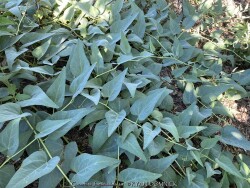

Buffalo Gourd (Cucurbita foetidissima) has large, gray-green, triangular leaves growing along long, prostrate stems. In the wild, the plants are often 20-30 feet across. Leaves are an attractive bluish green with a sandpapery texture. The large, bell-like flowers, 2-4 inches long, are yellow to orange, opening for only a day but blooming occurs over a month or so. The globular fruits, about 4 inches across, are green-striped when young, maturing to tennis-ball size and turning yellow. The plant supposedly gets the name "stink gourd" from its foul odor. Native to arid clay soils in Western Kansas, Colorado, the southwestern United States, and northern Mexico, the plant forms a fleshy tap root which is used to store water and nutrients. A large 10' wide specimen has flourished in our display garden in Lawrence, KS for over 10 years. It is planted in full sun in clay soil with no extra irrigation. It survived -16 degrees F and a week of single digit highs in February, 2021. It would be very useful as a vine-like perennial cascading over the top of a retaining wall! Amazing that a perennial native to areas receiving 5-10" of rain per year can grow in a climate receiving 5-10 times more rain!
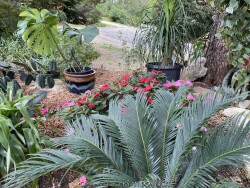

Cycad / Sago Palm (Tropical), is also known as Cycas revoluta
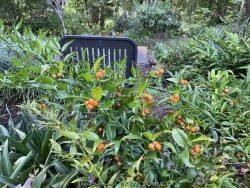

***Description for this plant available with future update!***
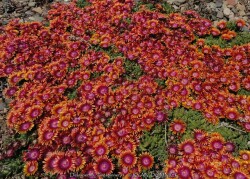

Fire Spinner Ice Plant (Delosperma 'Fire Spinner') has vibrant tri-colored flowers of orange, red and lavender that are one-of-a-kind. In Kansas, it is usually grown as an annual with outstanding color. Although very cold hardy, it cannot tolerate the combination of cold wet winters and occasionally dies even in summer from fungal diseases during hot humid weather. It could be an an evergreen groundcover under a South or West facing roof overhang against a house. Fire Spinner ice plant is sometimes grown as a hanging basket.


Fire Spinner Ice Plant (Delosperma 'Fire Spinner') has vibrant tri-colored flowers of orange, red and lavender that are one-of-a-kind. In Kansas, it is usually grown as an annual with outstanding color. Although very cold hardy, it cannot tolerate the combination of cold wet winters and occasionally dies even in summer from fungal diseases during hot humid weather. It could be an an evergreen groundcover under a South or West facing roof overhang against a house. Fire Spinner ice plant is sometimes grown as a hanging basket.
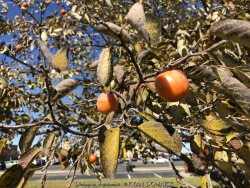

Native Persimmon Tree, is also known as Diospyros virginiana
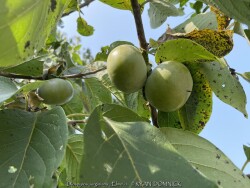

Elmo Persimmon Tree (Fruiting Cultivar), is also known as Diospyros virginiana 'Elmo' >>>>> According to Starks Bros "The Elmo American Persimmon is a hand-pollinated cross of Golden Supreme and Garretson Persimmon. It is also referred to as Claypool A-118. Chosen for its reliable crop of large fruits resistant to both pests and diseases. Elmo Persimmon is known for its heavy bearing. In Fall, enjoy harvesting large, orange, flavorful fruit with no black spots. Cross-pollination by a different variety is key to its growing and bearing success." Almost all American persimmon trees require a pollinator to bear fruit except 'Meader' and 'Yates'. Elmo Persimmons ripen in October to November with bright orange fruit. The fruit softens and sweetens once they experience frost.
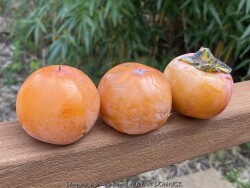

Yates Persimmon Tree (Fruiting Cultivar), is also known as Diospyros virginiana 'Yates'. >>>>> According to Starks Bros "A sweet native of Indiana. This fast-growing variety is pest- and disease-resistant. When fruit is soft and completely mature, it features a sweet, apricot-like flavor. Cold-hardy and heat-tolerant. Tree reaches 35-50' tall. Ripens in early September. Grafted. Self-pollinating. In Fall, enjoy harvesting large, orange, flavorful fruit with no black spots. Cross-pollination by a different variety is key to its growing and bearing success. Almost all American persimmon trees require a pollinator to bear fruit except 'Meader' and 'Yates'. Persimmons ripen in October to November with bright orange fruit. The fruit softens and sweetens once they experience frost. In many cases, you may still want to plant pollinating partners to increase the size of your crops, but with self-pollinating varieties doing so is optional. You'll get fruit with only one plant."
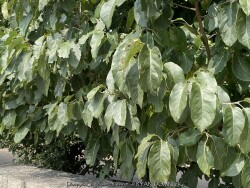

Yates Persimmon Tree (Fruiting Cultivar), is also known as Diospyros virginiana 'Yates'. >>>>> According to Starks Bros "A sweet native of Indiana. This fast-growing variety is pest- and disease-resistant. When fruit is soft and completely mature, it features a sweet, apricot-like flavor. Cold-hardy and heat-tolerant. Tree reaches 35-50' tall. Ripens in early September. Grafted. Self-pollinating. In Fall, enjoy harvesting large, orange, flavorful fruit with no black spots. Cross-pollination by a different variety is key to its growing and bearing success. Almost all American persimmon trees require a pollinator to bear fruit except 'Meader' and 'Yates'. Persimmons ripen in October to November with bright orange fruit. The fruit softens and sweetens once they experience frost. In many cases, you may still want to plant pollinating partners to increase the size of your crops, but with self-pollinating varieties doing so is optional. You'll get fruit with only one plant."
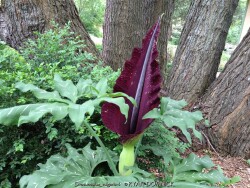

Voodoo lily (Dracunculus vulgaris) is a perennial tuber generally grown as a curiosity for its interesting foliage. The single leaf consists of a stalk (petiole) with mottled pinkish-gray and olive green coloration. The single intricate leaf has horizontal sections giving it a tropical umbrella-like effect. Larger tubers (about the size of a grapefruit or larger) may produce a single "flower" in spring before the foliage appears. The "flower" is actually a large shiny purple to maroon ruffled spathe. When in bloom it produces an odor like a dead animal for 1 day. This is intended to attract the carrion flies that are its natural pollinators. It is possible to overwinter these in the ground in Kansas by placing a 6-12" mound of mulch over deeply planted tubers. New growth will usually be delayed until June but quickly regains full height and will get bigger each year; buried tubers are hardy to zone 6a. They can also be grown as a flowering summer patio plant. If growing as a potted plant and trying to overwinter, allowing the foliage to frost is ok, it will not kill the root system. However, do not allow the pot with rootball to freeze solid or go below 20 degrees for more than a few hours; move into a cold garage or basement over the winter with no watering. Cut back and allow to go dormant and place entire pot back out in April or May with a time-release fertilizer.
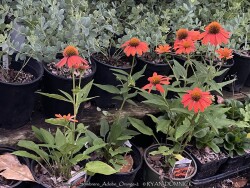

>>>>> Echinacea purpurea is an herbaceous perennial native to parts of eastern and midwestern United States most common in Missouri and Arkansas. Its habitats include dry open woods, prairies and barrens. Echinacea are native to North America, featuring sunflower-like flowers with a dark center and colorful petals. Colors on native plants include purple, magenta, white, yellow. Intensive breeding efforts to fish out recessive genes have brought bright orange and red into the picture. Flowers occur in early to mid summer often continuing into fall especially if dead-headed. Its individual flowers (florets) within the flower head are two-toned, having both male and female organs in each flower. (hermaphroditic) Bees and butterflies including the monarch are common pollinators. The dead flowers are attractive to some for winter interest but for those wanting a tidy your garden, they can be trimmed early. Leaving some dried seed heads will be beneficial for wildlife and provide winter food for finches and other birds. Best growth generally occurs in full to part sun with well drained soils with low to average moisture. In Eastern Kansas, typically our 40 inches of rainfall is sufficient without extra water. Coneflower can also handle short one to two day flooding events and are sometimes used along the higher perimeter of rain gardens to bring in pollinators. Coneflower mixes well with many other types of plants ranging from other native plants to evergreens to hardy tropicals. Rabbits can be a problem young immature plants. A popular method of control is covering the plant with an upside down bowl-shaped chicken wire cage for the first year to allow basil foliage to establish well. You can quickly make these yourself with a low cost roll of chicken wire. Mature plants especially in groups with other mature landscaping generally do not have rabbit problems. Flowers are also popular in the florist industry as cut flowers or in the cottage garden. The genus echinacea has undergone intense breeding with the introduction of hundreds of new cultivars in the last 10 years.
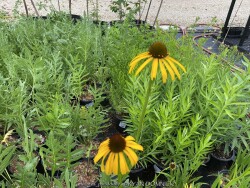

>>>>> Echinacea purpurea is an herbaceous perennial native to parts of eastern and midwestern United States most common in Missouri and Arkansas. Its habitats include dry open woods, prairies and barrens. Echinacea are native to North America, featuring sunflower-like flowers with a dark center and colorful petals. Colors on native plants include purple, magenta, white, yellow. Intensive breeding efforts to fish out recessive genes have brought bright orange and red into the picture. Flowers occur in early to mid summer often continuing into fall especially if dead-headed. Its individual flowers (florets) within the flower head are two-toned, having both male and female organs in each flower. (hermaphroditic) Bees and butterflies including the monarch are common pollinators. The dead flowers are attractive to some for winter interest but for those wanting a tidy your garden, they can be trimmed early. Leaving some dried seed heads will be beneficial for wildlife and provide winter food for finches and other birds. Best growth generally occurs in full to part sun with well drained soils with low to average moisture. In Eastern Kansas, typically our 40 inches of rainfall is sufficient without extra water. Coneflower can also handle short one to two day flooding events and are sometimes used along the higher perimeter of rain gardens to bring in pollinators. Coneflower mixes well with many other types of plants ranging from other native plants to evergreens to hardy tropicals. Rabbits can be a problem young immature plants. A popular method of control is covering the plant with an upside down bowl-shaped chicken wire cage for the first year to allow basil foliage to establish well. You can quickly make these yourself with a low cost roll of chicken wire. Mature plants especially in groups with other mature landscaping generally do not have rabbit problems. Flowers are also popular in the florist industry as cut flowers or in the cottage garden. The genus echinacea has undergone intense breeding with the introduction of hundreds of new cultivars in the last 10 years.
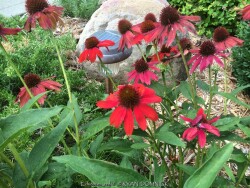

>>>>> Echinacea purpurea is an herbaceous perennial native to parts of eastern and midwestern United States most common in Missouri and Arkansas. Its habitats include dry open woods, prairies and barrens. Echinacea are native to North America, featuring sunflower-like flowers with a dark center and colorful petals. Colors on native plants include purple, magenta, white, yellow. Intensive breeding efforts to fish out recessive genes have brought bright orange and red into the picture. Flowers occur in early to mid summer often continuing into fall especially if dead-headed. Its individual flowers (florets) within the flower head are two-toned, having both male and female organs in each flower. (hermaphroditic) Bees and butterflies including the monarch are common pollinators. The dead flowers are attractive to some for winter interest but for those wanting a tidy your garden, they can be trimmed early. Leaving some dried seed heads will be beneficial for wildlife and provide winter food for finches and other birds. Best growth generally occurs in full to part sun with well drained soils with low to average moisture. In Eastern Kansas, typically our 40 inches of rainfall is sufficient without extra water. Coneflower can also handle short one to two day flooding events and are sometimes used along the higher perimeter of rain gardens to bring in pollinators. Coneflower mixes well with many other types of plants ranging from other native plants to evergreens to hardy tropicals. Rabbits can be a problem young immature plants. A popular method of control is covering the plant with an upside down bowl-shaped chicken wire cage for the first year to allow basil foliage to establish well. You can quickly make these yourself with a low cost roll of chicken wire. Mature plants especially in groups with other mature landscaping generally do not have rabbit problems. Flowers are also popular in the florist industry as cut flowers or in the cottage garden. The genus echinacea has undergone intense breeding with the introduction of hundreds of new cultivars in the last 10 years.


Pale Purple Coneflower, is also known as Echinacea pallida
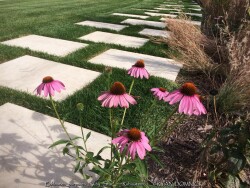

>>>>>Echinacea purpurea is an herbaceous perennial native to parts of eastern and midwestern United States most common in Missouri and Arkansas. Its habitats include dry open woods, prairies and barrens. Echinacea are native to North America, featuring sunflower-like flowers with a dark center and colorful petals. Colors on native plants include purple, magenta, white, yellow. Intensive breeding efforts to fish out recessive genes have brought bright orange and red into the picture. Flowers occur in early to mid summer often continuing into fall especially if dead-headed. Its individual flowers (florets) within the flower head are two-toned, having both male and female organs in each flower. (hermaphroditic) Bees and butterflies including the monarch are common pollinators. The dead flowers are attractive to some for winter interest but for those wanting a tidy your garden, they can be trimmed early. Leaving some dried seed heads will be beneficial for wildlife and provide winter food for finches and other birds. Best growth generally occurs in full to part sun with well drained soils with low to average moisture. In Eastern Kansas, typically our 40 inches of rainfall is sufficient without extra water. Coneflower can also handle short one to two day flooding events and are sometimes used along the higher perimeter of rain gardens to bring in pollinators. Coneflower mixes well with many other types of plants ranging from other native plants to evergreens to hardy tropicals. Rabbits can be a problem young immature plants. A popular method of control is covering the plant with an upside down bowl-shaped chicken wire cage for the first year to allow basil foliage to establish well. You can quickly make these yourself with a low cost roll of chicken wire. Mature plants especially in groups with other mature landscaping generally do not have rabbit problems. Flowers are also popular in the florist industry as cut flowers or in the cottage garden. The genus echinacea has undergone intense breeding with the introduction of hundreds of new cultivars in the last 10 years. Sunset Coneflower / Red-Orange Coneflower (Echinacea x Sunset) features red-orange and pinkish flowers. Most orange or red types if allowed to self-seed will produce purple flowering plants.
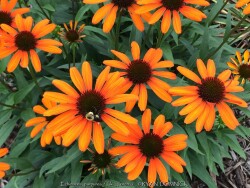

Echinacea purpurea is an herbaceous perennial native to parts of eastern and midwestern United States most common in Missouri and Arkansas. Its habitats include dry open woods, prairies and barrens. Echinacea are native to North America, featuring sunflower-like flowers with a dark center and colorful petals. Colors on native plants include purple, magenta, white, yellow. Intensive breeding efforts to fish out recessive genes have brought bright orange and red into the picture. Flowers occur in early to mid summer often continuing into fall especially if dead-headed. Its individual flowers (florets) within the flower head are two-toned, having both male and female organs in each flower. (hermaphroditic) Bees and butterflies including the monarch are common pollinators. The dead flowers are attractive to some for winter interest but for those wanting a tidy your garden, they can be trimmed early. Leaving some dried seed heads will be beneficial for wildlife and provide winter food for finches and other birds. Best growth generally occurs in full to part sun with well drained soils with low to average moisture. In Eastern Kansas, typically our 40 inches of rainfall is sufficient without extra water. Coneflower can also handle short one to two day flooding events and are sometimes used along the higher perimeter of rain gardens to bring in pollinators. Coneflower mixes well with many other types of plants ranging from other native plants to evergreens to hardy tropicals. Rabbits can be a problem young immature plants. A popular method of control is covering the plant with an upside down bowl-shaped chicken wire cage for the first year to allow basil foliage to establish well. You can quickly make these yourself with a low cost roll of chicken wire. Mature plants especially in groups with other mature landscaping generally do not have rabbit problems. Flowers are also popular in the florist industry as cut flowers or in the cottage garden. The genus echinacea has undergone intense breeding with the introduction of hundreds of new cultivars in the last 10 years. Several cultivars featuring the break-thru orange color. Older varieties were less vigorous but new varieties are much improved. Most orange or red types if allowed to self-seed will produce purple flowering plants.
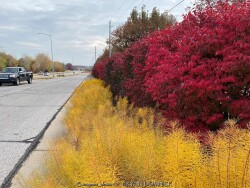

***Shrub descriptions available with future update!*** >>>>> Spring Meadow Nursery says "Better stem hardiness than typical dwarf burning bush. Fire Ball® burning bush is an improved selection of compact burning bush with tighter branching and superior hardiness. Other varieties of burning bush may experience die-back during harsh winters; Fire Ball® euonymus has experienced zero damage even in the coldest of Midwestern winters"
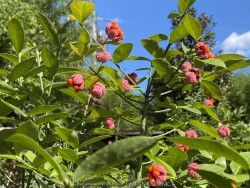

Native Strawberry Bush, is also known as Euonymus americanus
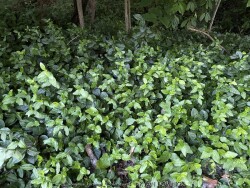

Purple Wintercreeper (Euonymus fortunei 'Coloratus') makes a durable evergreen groundcover that starts off slow, but grows quickly after a few years to forms a dense, weed-smothering mat of foliage. As one of the most dry-shade tolerant plants there is, it's thick leathery leaves seem to handle everything nature has to throw at it! That being said, beware that this is an extremely vigorous plant that crowds out most weeds and is itself weed-like, with a very spreading growth habit. After establishment, it is high maintenance if it has already filled the space and you don't want it to spread any further: it even resists Round-up! It will climb trees if you allow it, generally using it for support to allow its mature form to develop and flowering to occur. From there, red-orange seeds develop that are spread everywhere and will overrun nearby native forests in Eastern Kansas. For the home garden, the species is generally too aggressive to mix with other plants. At our plant nursery, since we cannot eradicate it, we have allowed it to cover a tall fence along the back of our property where it has crept in from the neighboring woods. It does form a nice evergreen screen as it weaves into the trees.


Variegated Fallopia, is also known as Fallopia japonica 'Variegata'
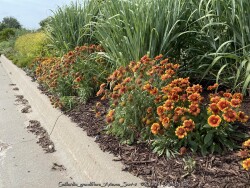

Arizona Sun Blanket Flower (Gaillardia aristata 'Arizona Sun') is an improved variety with an intense covering of red and yellow flowers in the summer. Blooming usually starts during the heat of summer and continues until frost. Foliage is mint green and attractive. Blanket flower is native to dry sandy areas of the lower great plains including Texas, New Mexico, and Arizona. Because of its desert heritage, it resents cold wet winters and needs well drained sandy, silty, or rocky soil. Short periods of extra water is tolerated in the heat of summer especially after blooming has started. It will typically grow in any soil and bloom like crazy during the summer making it very useful even as an annual if planted in the wrong soil type. In Kansas landscapes, it is commonly used as an annual or short-lived perennial where lots of color is needed in full sun. Self-seeding is possible in areas that are not mulched. Gaillardia combines nicely with any blue or purple flower including catmint, false indigo, plumbago.
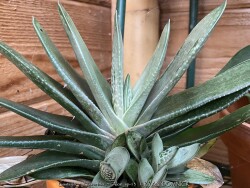

These succulents are usually spineless and grown for their beautiful shapes, color and texture. Gasteria / Haworthia / Aloe are usually grown as small patio or house plants in Kansas. In the wild, some species are hardy to below 20 degrees F. Grow in part sun to full shade with little extra watering except that which comes from rainfall. Repotting may or may not be needed depending on how large you want the plant to grow; plants can continue to grow and tolerate extremely root-bound pots but will eventually need thinned or repotted. If repotting, make sure to use a sharp draining low organic cactus mix with plenty of sand and perlite. To play is safe, potted plants are best moved in before night temperatures get below 45 degrees F. It is important to avoid the combination of wet and cold. Move to a bright interior window over the winter with no watering and keep above freezing. As a winter house plant, it will look presentable all winter long with just a few waterings. As a permanent house plant, provide bright light and allow the soil to dry between waterings for many years of carefree enjoyment. Generally if moving outside for the summer, keep in part to full shade. Some species will acclimate and thrive in full sun but be careful not to rush it or sunburning will occur; move into sun gradually over a few weeks. Potted plants are very low maintenance but avoid too much water or plants will rot.
